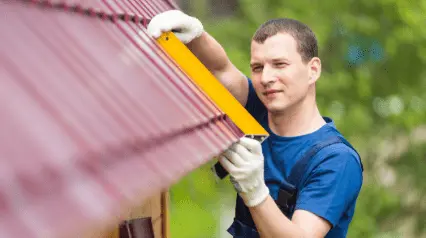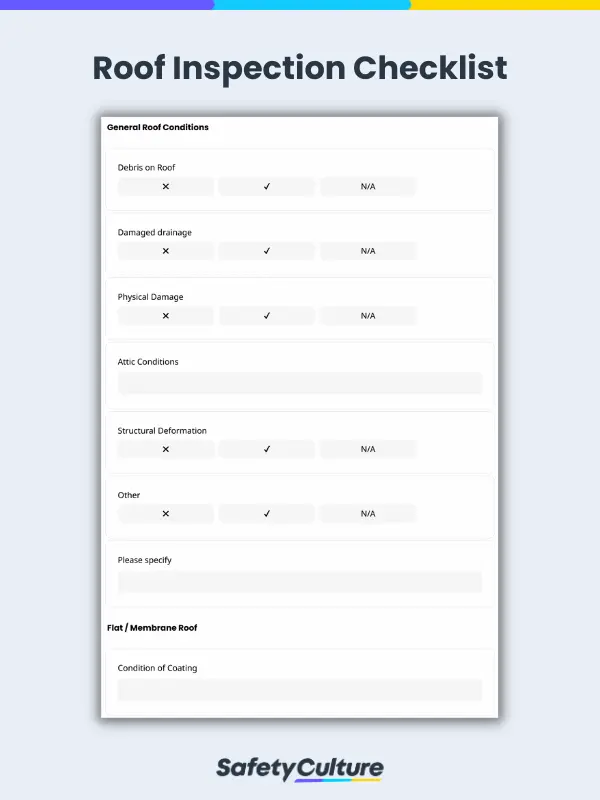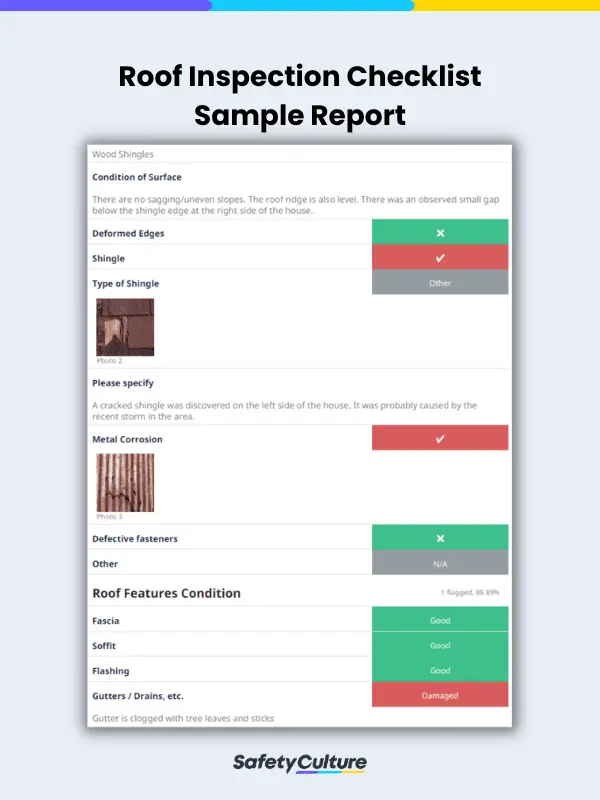What is a Roof Inspection Checklist?
A roof inspection checklist is a tool for workers to spot and record safety hazards during roof work. It’s used to identify risks and ensure they’re addressed with safety controls like safety training and PPE. These checklists, also known as roof safety inspections or forms, are done routinely or as needed—scheduled or prompted by concerns, incidents, or worker reports.
Importance and Benefits
The construction industry in general is already considered one of the most dangerous industries to work in. Roofers, a sub-branch of construction workers, are currently ranked #5 in a recent list of the 25 most dangerous jobs in America. Hence, the importance of roof safety inspections is reinforced to help ensure roofers’ exposure to risks and hazards is minimized or completely eliminated.
However, the benefits of such inspections extend beyond the physical safety and well-being of roof workers. If consistently conducted, the following benefits can also be achieved:
- Detect Potential Issues Early: Following a consistent checklist for roof inspections allows for early problem detection. Issues like storm damage, leaks, missing shingles, and structural damage can be addressed before they turn into a major concern. This then enables timely repairs or maintenance, preventing minor problems from escalating into major, costly issues.
- Extend Roof Lifespan: By identifying and addressing issues promptly, inspections help prevent further roof deterioration. Proactive maintenance and repairs can also significantly extend the roof’s lifespan, saving homeowners or building owners from premature roof replacement expenses.
- Increase Property Value: Keeping a record of the roof’s condition can help homeowners or building owners demonstrate the roof’s care and maintenance history to potential buyers or tenants. This can positively influence property value and attract prospective buyers or renters.
- Protect Worker Morale: Employers’ lax safety measures can damage worker morale by neglecting to manage work-related stress, particularly critical for roofers facing constant hazards. Regular roof safety inspections reassure workers that their safety is valued and prioritized, boosting morale.
- Improve and Maintain Brand Reputation: Major worker injuries or fatalities not only traumatize those involved but also tarnish your company’s reputation. Diligent roof inspections demonstrate compliance with roof safety requirements and highlight your commitment to safety, preventing such incidents positively influences brand reputation.
- Save Money: Worker injuries, fatalities, and Occupational Safety and Health Administration (OSHA) fall protection violations incur significant costs. By instituting a regular roof safety inspection process, the likelihood of these incidents can be significantly reduced. Inspection checklists aid your inspection team in maintaining consistency and adhering to your safety standards during roof inspections.
How to Conduct Roof Inspections
Performing basic roof inspections can be summarized into 5 simple steps:
- Conduct a visual inspection of the roof surface: Check for visible damages and indications of aging.
- Inspect gutters and downspouts: Check for debris and blockages and ensure the downspouts are properly positioned and that there aren’t any cracks or clogs.
- Evaluate flashing and seals around penetrations: Check for signs of wear or damage and leaks.
- Examine roof interior: Look for water stains, mold, moisture, or other signs of leak.
- Document findings and schedule repairs: For a more detailed report, add notes and attach photos during the inspection. Assign and schedule repairs and maintenance if determined necessary.
It’s important to keep in mind that safety should be a priority when inspecting roofs. With this, you must use recommended safety equipment, such as a sturdy ladder and appropriate PPE. Also, exercise caution while walking on the roof surface.
What to Include in a Roof Inspection Checklist
When inspecting your roof, there are several important items you should check to ensure its good condition and identify any potential issues. Here are some key items to include in your roof inspection checklist:
- Roofing Materials – Check the condition of the roofing materials, such as shingles or metal panels. Look for signs of damage, including cracks, missing pieces, curling, or blistering.
- Flashing – Inspect the flashing, which is the metal or rubber material installed around roof penetrations (such as chimneys, vents, or skylights) and along roof edges. Make sure the flashing is secure, intact, and properly sealed to prevent water intrusion.
- Gutters and Downspouts – Examine the gutters and downspouts for debris accumulation, clogs, or damage. Ensure that they are securely attached to the roof edge and properly channeling water away from the foundation.
- Roof Leaks – Look for any signs of water stains or leaks on the interior ceilings or walls. Pay attention to areas near vents, chimneys, or skylights, as they are more prone to leaks.
- Roof Decking – Check the roof decking for signs of sagging, rot, or water damage. Inspect both the exterior and interior sides of the roof for any visible issues.
- Chimneys – Inspect the chimney for any loose or deteriorating bricks, damaged mortar, or cracked chimney caps. Ensure that the flashing around the chimney is secure and watertight.
- Skylights – If you have skylights, carefully examine the seals around them to check for any signs of leakage. Inspect the glass or acrylic panels for cracks or damage.
- Attic – If accessible, inspect the attic for signs of moisture, water stains, or mold growth. Check for proper insulation and ventilation in the attic space.
The National Association of Certified Home Inspectors (NACHI) Standards of Practice (SOP) or the manufacturer’s installation guide for roofing systems can be helpful references for inspectors in creating roof inspection checklists.
FAQs About Roof Inspection Checklists
The frequency of roof inspection checklists to be updated varies on changes in roofing materials, technology, regulations, and any other specific concerns or issues identified during previous inspections.
Yes, a roof inspection checklist can be used for commercial roofs. While variations exist in specific items compared to residential lists, the fundamental purpose remains: assessing conditions and identifying potential issues, albeit on a larger scale.
Yes, keeping a record of completed roof inspection checklists is helpful. Doing so is beneficial for proper documentation, tracking of maintenance and repairs, proof of compliance with regulatory standards, and more.




